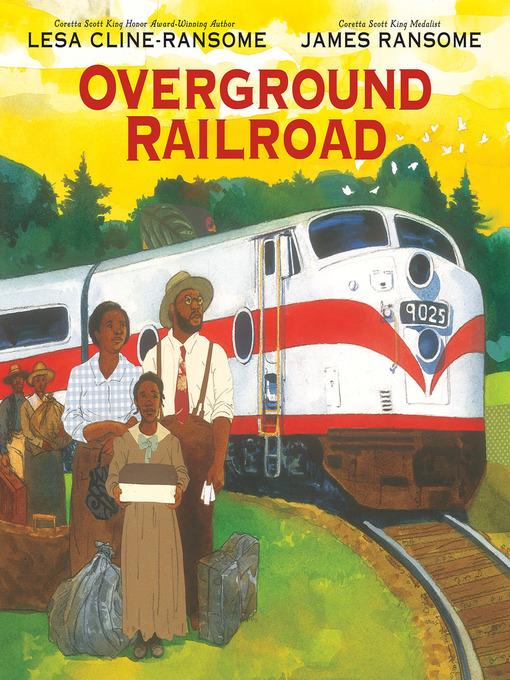
Overground Railroad
فرمت کتاب
ebook
تاریخ انتشار
2020
Lexile Score
1000
Reading Level
2-3
ATOS
4.2
Interest Level
K-3(LG)
نویسنده
James E. Ransomeناشر
Holiday Houseشابک
9780823443901
کتاب های مرتبط
- اطلاعات
- نقد و بررسی
- دیدگاه کاربران
نقد و بررسی

Starred review from October 14, 2019
Warm portraiture and vivid writing by married collaborators Cline-Ransome and Ransome (Before She Was Harriet) mark this story of a family’s journey north during the Great Migration. Ruthie narrates; she and her Mama and Daddy are leaving the fields of North Carolina for New York City aboard the Silver Meteor: “No more working someone else’s land,” Mama says. When the train crosses from the segregated South into the North, porters tell “everyone in the colored section/ to sit where they want.” Some white passengers put their hands over empty seats, but the three find “smiles/ from new neighbors.” Ransome renders the scenes realistically in bold colors, strong lines, and delicate collage-like patterns. He moves in close to capture Ruthie’s serious gaze and her parents’ gentle exchange. Ruthie’s teacher has given her a copy of Narrative of the Life of Frederick Douglass, and Ruthie is quick to perceive the parallels: “a boy/ leaving behind what he knew/ and heading to what he don’t/ just like me.” The journey is seen through the eyes of richly developed characters drawn with care and sympathy. Ages 4–8.

Starred review from December 1, 2019
One family's experience of the Great Migration. Cline-Ransome and Ransome, a husband-and-wife author-and-illustrator team, have again collaborated on an important story from African American history. Narrator Ruth Ellen, Mama, and Daddy awaken early to travel to New York without the permission or knowledge of the landowner on whose land they sharecrop. (The author's note mentions that landowners often used threats and violence to keep sharecroppers on the land and perpetually in debt.) The family boards the train with luggage, tickets, and food in a shoebox--since black folks cannot eat in the dining car and must sit in the colored section of the train. The conductor calls out the cities as they progress North. When the conductor removes the "whites only" sign near Baltimore, African Americans can sit wherever they want--though it takes some time before Ruth Ellen and her family find white riders who smile a welcome. Ruth Ellen reads Narrative of the Life of Frederick Douglass aloud to Mama on the train ride, a gift from her teacher that parallels her own family's journey. Ransome's watercolor-and-collage illustrations effectively capture both the historical setting and the trepidation of a family who though not enslaved, nevertheless must escape as if they were. Cotton bolls throughout the images accentuate cotton's economic dominance in the sharecropping system. A beautiful portrayal of a historic and arduous family journey northward. (Picture book. 4-8)
COPYRIGHT(2019) Kirkus Reviews, ALL RIGHTS RESERVED.

February 21, 2020
K-Gr 2-Cline-Ransome and Ransome apply their considerable talents to this timely story about migration and a hope for a better life. At the crack of dawn, Ruth Ellen and her father and mother board the New York-bound Silver Meteor, the first train out of North Carolina that day. They board in secret, having already said their goodbyes to the family members who will stay behind. As they travel, Ruth Ellen reads aloud from her book, Narrative of the Life of Frederick Douglass, a parting gift from her teacher. Finally, as night falls, they arrive at Penn Station and Ruth Ellen steps off the train into the city that is their new home while the bright lights of the city shine like stars. Ransome's beautiful illustrations feature detailed and expressive faces and layers of bright patterned paper that add colorful accents to the muted palette. The faces of the white passengers are all cut from a single shade of white paper while the black passengers skin tones vary, reflecting the diversity of the participants of the Great Migration. The inclusion of information about Frederick Douglass's journey in the story helps show that even though Ruth Ellen's journey north is more comfortable in comparison, she and her family still experience the same uncertainty and apprehension on their trip. Ruth Ellen's narration brings an immediacy to the trip, her thoughts often interrupted by the train conductor's shouts of, "Next Stop..." as they move along. An author's note gives readers historical context, placing the story in the era of the Great Migration, inspired by just one story of the many who were, "running from and running to at the same time." VERDICT An excellent and highly recommended first purchase.-Laken Hottle, Providence Community Library
Copyright 2020 School Library Journal, LLC Used with permission.

Starred review from February 1, 2020
Preschool-G *Starred Review* Leaving in secret, before Daddy's boss knew, / before our lease was up, Ruth Ellen and her parents rise before dawn, bid their relatives goodbye, and board the Silver Meteor, an early morning train bound for New York. The colored car grows more crowded at each stop, but north of Washington, D.C., they can legally sit in any car. They move to another, ignoring certain passengers' silent hostility. Every mile carries this family toward The Promised Land. Reading a biography of Frederick Douglass, who had traveled north long ago, Ruth Ellen reflects, We all running from / and running to / at the same time. The free-verse text reads aloud gracefully, telling one family's story with concise, resonant phrases and sensory details, while including allusions to history, religion, and culture, which a parent or teacher could discuss further. An appended note clarifies the term overground railroad, referring to the railways that enabled Black sharecroppers to escape the coercive tenant farms in the South and move northward. Created with cut-paper collage, graphite, pastel pencil, and watercolors, the captivating illustrations include strong, evocative character portrayals, beautifully composed landscapes, and unexpected combinations of patterns and colors that work together well. A memorable introduction to the Great Migration.(Reprinted with permission of Booklist, copyright 2020, American Library Association.)

























دیدگاه کاربران